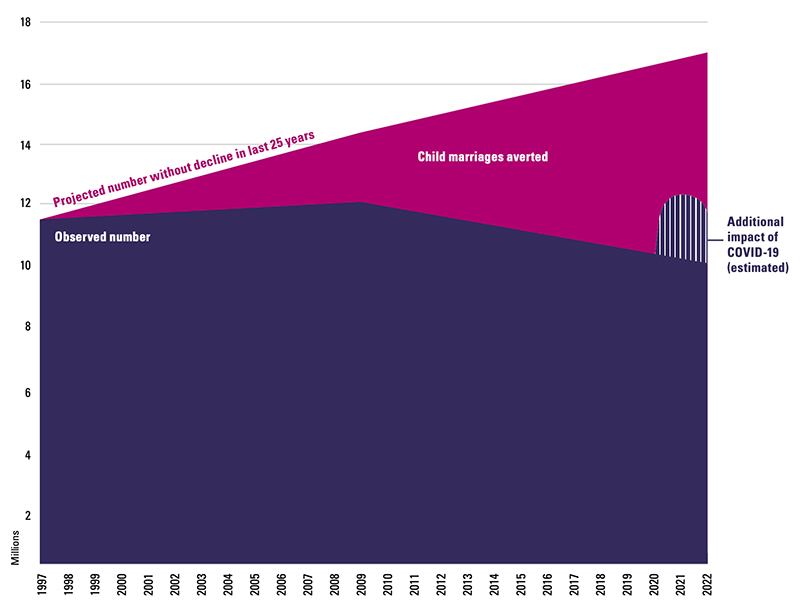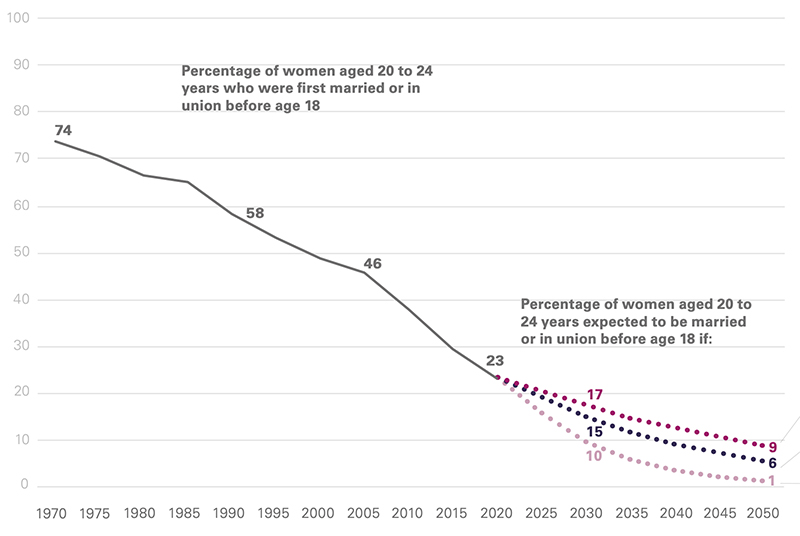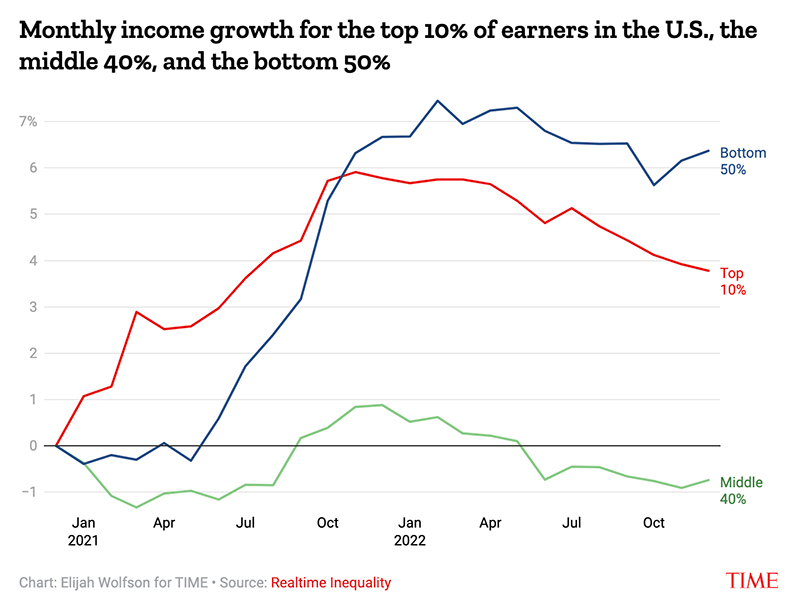Volcanoes are erupting in The Philippines, but on-fire Australia received some welcome rain. The Iran war cries have been called off and The Donald’s military powers are about to be hamstrung by the Senate. Meanwhile, his impeachment trial is starting, and we’re all on Twitter for a front-row seat.
What Could Go Right? 68 million child marriages averted
Steep declines in South Asia have pushed progress along.
This is our weekly newsletter, What Could Go Right? Sign up here to receive it in your inbox every Thursday at 6am ET. You can read past issues here.
68 million child marriages averted
“Child marriage in decline—but will take 300 years to eliminate.” “Child marriage rate falling too slowly.” Headlines about the recently released United Nations Children’s Fund (UNICEF) report on child marriage borderlined on the dour.
There is plenty to be dour about. In the future, it’s likely sub-Saharan Africa will have more child brides as populations there increase without strong economic development. It’s forecasted that the Covid-19 pandemic interrupted progress on reducing child marriage rates, although data is not yet available. Progress has stagnated in some regions. And the “too slowly” comment is in regard to the UN’s Sustainable Development Goals (SDGs), which were adopted in 2015. Ending child marriage by 2030—an ambitious goal—was one of them, and it’s highly unlikely to be met.
The basic finding of the report, though, is positive. Child marriage is on the decline, particularly in South Asia, where almost half of child brides live. Globally, an estimated 68 million child marriages were averted in the past 25 years.

In the last decade, the likelihood of a girl from South Asia marrying in childhood has dropped from 46 to 26 percent. Of the area’s countries, Sri Lanka and Bhutan have the same child marriage rates of 25 years ago. But Bangladesh, Nepal, Afghanistan, and Pakistan have all registered substantial declines, and Maldives is close to eliminating child marriage entirely. Maldives didn’t start from an already low rate, either. Twenty-five years ago, the prevalence rate of child marriage there was over 50 percent. Now it’s two percent.
If we’re talking sheer numbers, though, the leader of the group is India. Because of its huge population, India alone accounts for one-third of the world’s child brides, says the report. Prevalence rates there have dropped as well, from 74 percent in 1970 to 23 percent in 2020.

This is why trends like the ones I mentioned last week, that India is urbanizing and becoming richer, are so exciting. These trends have many ripple effects—child brides in India (and other countries) are more likely to live in poor households, have less education, and reside in rural areas. Around the world, where there has been economic development, poverty reduction, and access to employment and education, so too have there been fewer girls getting married. Indeed, as the report shows, in some places child marriage rates have increased recently among the poorest. A bit simplistically: it is good on multiple levels when people have more money.
As always, a lot remains to be done. There are challenges ahead, and in many ways it makes sense to keep emphasizing those in the media coverage, as many outlets have. The organizations that help make all this progress need funding, after all!
But they—and we—might need a little cheerleading, too. While writing this I was reminded of a conversation I had with an acquaintance who works on UNICEF child poverty campaigns. She was stunned when I told her that poverty globally is on the decline, and asked me to send her some data. She told me it would be really helpful to know that what she does actually makes a difference. So this summary is offered in that spirit.
Quick hits
To bolster the point our collaboration with Warp News on the sixth mass extinction made: humans care a lot about saving animals. So much so that we’re trying to save koalas from chlamydia.
Chimpanzees talk to each other, kinda. Specifically, about snakes.
The case for climate optimism. And, with Americans’ trust in media and the government near record lows, what can be done to repair some of the faith that has been lost? Writer Katherine Brodsky has some ideas.
Below in the links section, swimming in the Seine, brain surgery in a fetus, Frankfurt to Dubai in under two hours, and more.

Op-ed: The Trust Factor

With trust in the media and government near record lows, what can be done to repair some of the faith that has been lost? | Read more
Demon Drugs and Moral Panics | S4 E13

Is drug use always harmful? How does empathy play a role in addiction? Could it be more beneficial to approach drug use as a public health issue rather than a criminal one? In this episode, we speak with Maia Szalavitz, an award-winning journalist and author, about the potential benefits of harm reduction for addiction treatment and addressing larger societal issues. Plus, we take a look at smart guns and serial killers. | Listen to the episode
Progress, Please
(Found good news? Tweet at us @progressntwrk or email.)
Other good stuff in the news 🥥
Energy & Environment:
- A Caribbean island’s quest to become the world’s first climate-resilient nation | BBC
- Fortified with coconuts, ‘living’ shorelines are stopping coastal erosion | Reasons to Be Cheerful
- World’s largest battery maker announces major breakthrough in energy density | The Driven
- In Norway, the EV future has already arrived | The New York Times
- How the Netherlands plans to spend €28B on slashing emissions by 2030 | Euronews
- The state of electric school bus adoption in the US | World Resources Institute
- Paris plans swimming areas for its iconic Seine River | Bloomberg
- A ray of hope for some coral reefs | EcoWatch
- World’s largest carbon capture facility will store 9M tonnes of CO2 yearly | Interesting Engineering
Public Health:
- Covid is no longer a global health emergency, WHO says | Semafor
- US death rate falls as Covid slips to 4th most common cause of death | Axios
- Australia’s homicide rate is down over 50% from the 1990s | The Conversation
- Doctors have performed brain surgery on a fetus in one of the first operations of its kind | MIT Technology Review
- US drug regulator approves world’s first RSV vaccine | BBC
Science & Tech:
- China approves safety of first gene-edited crop | Reuters
- Google rolls out passkey technology in ‘beginning of the end’ for passwords | The Guardian
- Frankfurt to Dubai in 90 minutes? Europe enters the hypersonic plane race | CNN
- Small portable nuclear reactors could power up to 1,000 households, here’s how they work | Interesting Engineering
Politics & Policy:
- Illinois assault weapons ban back in effect as courts play ping pong with gun control | Fox News
- NY governor signs bill expanding access to contraceptives | AP
- US District Court drops gavel on Kansas’ unconstitutional attack of advance mail-in voting | Kansas Reflector
- The unexpected women blocking South Carolina’s near-total abortion ban | The New York Times
- $2.5M Gen Z program aims to expand career options for high school students | The 74
Society & Culture:
- Colleges are adding programs to recruit and support men | The Hechinger Report
- Small acts of kindness are frequent and universal, study finds | ScienceDaily
Economy:
- Robust hiring in April shows US job market remains hot in cooling economy | The Wall Street Journal
- An unemployment rate milestone for Black Americans | Axios
- No, average college grads didn’t make $100K in the 1980s | Reason
TPN Member originals 🧠
(Who are our Members? Get to know them.)
- Kevin Kelly on advice, travel, and tech | Tyler Cowen
- The battle for control in Sudan | Faisal Saeed Al Mutar
- How to feel like your work matters | Jason Feifer
- Ukraine’s counteroffensive: Prospects for success, unity, and peace | Ian Bremmer
- The FTC’s Lina Khan vs. GenAI | James Pethokoukis
- There is no turning back on AI | Tyler Cowen
- The hidden source of AI’s emerging power | Robert Wright
- AI is about to make social media much more toxic | Jonathan Haidt
- What our toxic culture does to the young | David Brooks
- A killing on the F train | John McWhorter
- On crime, policing, and policy | Jennifer Doleac
- Illiberalism is a threat to democracy—on the right and left | Theodore R. Johnson
- The US government keeps breaking the economic golden rule: Do no harm | Zachary Karabell
- William Deresiewicz on the ‘excellent sheep’ of the American elite | Yascha Mounk
- My Covid brain | Deborah Fallows
- Multiverse of madness | David Deutsch
Department of Ideas 💡
(A staff recommendation guaranteed to give your brain some food for thought.)
Internet: a user manual | Escaping Flatland
You can tap your fingers so that the world you live through the screen becomes a piece of art.
Why we picked it: I deleted my Twitter account in 2014 and have regretted it exactly zero times since. Last month, though, when Substack introduced its new Twitter-like Notes feature, I decided to give it a try. Predictably, I was on the fence about it. But then, via an exchange on Notes, I found this great essay, which has helped me to see the internet (and social media) as a practice. It has also inspired me to “block and prune” some of the more negative online reading habits from my life. Join me? —Brian Leli
Until Next Time
Strega Nona lives! In New Jersey, apparently. 🍝


